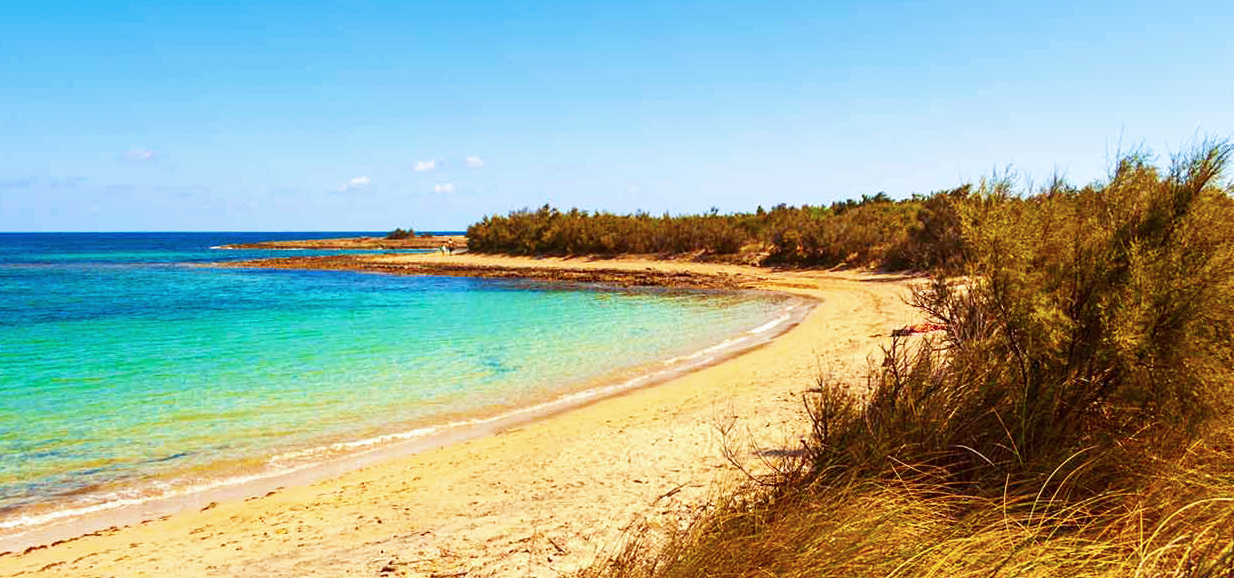Brindisi is a province in the region of Apulia in southern Italy. Its capital, also called Brindisi is located on the coast of the Adriatic Sea. Throughout history, the city and province have played an important role in trade and culture due to its strategic position on the Italian peninsula and its natural port on the Adriatic Sea.
Known as the ‘Gateway to the East’ since ancient times, Brindisi became a strategic port, first for the Roman troops and later for the merchants of Venice. This port in Apulia even today provides important travel connections to and from a long list of sea and airports.
Because the weather is mild throughout the year and its shoreline is sandy for the entire stretch of coast, tourism thrives. You will encounter charming vacation destinations situated nearby ancient artifacts from Roman times.
To the north of the province is the Murge Plateau where it meets the Itria Valley. This is known as the ‘Land of the Trulli.’ Cultivated fields alternate with large expanses of olive groves, vineyards and colorful orchards, interrupted only by roads and sporadic clearings. Ancient villages dominated by fortresses and watchtowers tell the story of Frederick II and the Angevin domination, but even more ancient testimonies relate the presence of the prehistoric Messapian civilization. There are several theories concerning its founders, but no one can question the area’s importance in ancient civilization. Artifacts dating from the 7th century BC have been uncovered in the province 500 years before it was conquered in 267 BC by the Romans.
After the Punic Wars it became a major center of Roman naval power and maritime trade. Later when it received Roman citizenship, it was made a free port. The poet Pacuvius was born in Brindisi about 220 BC and the famous poet Virgil died there in 19 BC. Under the Romans, Brundisium had some 100,000 inhabitants. It was connected with Rome by the Via Appia and the Via Traiana. The termination of the Via Appia at the water’s edge used to be flanked by two columns. They were once thought to mark the ending points of the Appian Way; instead they were used as a port reference for the antique mariners. Only one of the two is still standing and is 61.5 feet tall. The other column crumbled in 1582, but the ruins was given to Lecce to hold the statue of Saint Oronzo (Lecce’s patron), because Saint Oronzo was reputed to have cured the plague in Brindisi.
During the Dark Ages, Brindisi was conquered and reconquered again and again, first by the Ostrogoths, followed by the Byzantine Empire, then the Lombards. In 1070, it was conquered by the Normans and became part of the Principality of Taranto and the Duchy of Apulia. The province later had a resurgence during the period of the Crusades due to its strategic port location and the 11th and 12th centuries saw the construction of the new cathedral and defensive castles. While there, plan a visit to the two fortresses of Brindisi – the Castello Svevo (Castello Grande) was built by Emperor Frederick II. Under the Crown of Aragon, four towers were added to the original 13th century structure. After 1909, it was used by the Italian Navy and during World War II was briefly the residence of King Victor Emmanuel III. The other fortress, the Aragonese Castle is better known as the Forte a Mare (Sea Fort) and was built by King Ferdinand I of Naples in 1491 on the S. Andrea Island facing the port.
While wandering through the town of Brindisi, you will find ancient palaces, the beautiful cathedral, narrow alleys and old houses full of charm. It may be the case that the best way to explore the old town is by getting lost! The center is quite small so you will arrive at your starting place at some point. Missing the cathedral and the beautiful Palazzo Arcivescovile overlooking the square is almost impossible. Each are right in the heart of the city. There are many signs and whoever you ask will show you the right way. The Duomo was built in the Romanesque style but was destroyed by an earthquake in 1743. What is visible today is the 18th century reconstruction, but parts of the original mosaic pavement can be seen in the interior.
Nearby is the Portico of the Templars, an amazing architectural sight. The medieval building is located in Piazza Duomo. It was the medieval Palace of the Archbishop and is now the entrance to the Museo Ribezzo. The name of the palace is connected with the nearby Church of the Knights Templar. This refers back to the time of the Crusades and the importance and power once wielded by the Knights. Inside the historical museum you will find preserved medieval artifacts, including a beautiful stone sarcophagus.
The superb Church of San Giovanni al Sepolcro can be a little trickier to find. It is hidden in a small alley near the Cathedral. It is definitely a must-see in Brindisi; make sure to ask at your hotel or check a map to find it. Spend a few minutes outside admiring the finely carved old capitals and then move inside, where you’ll see a wonderful example of the Romanesque style. Then take a stroll to the waterfront, stop for a drink at one of the cafés and enjoy the wonderful scent of the sea. There’s often a nice breeze making it a great place to escape the heat. In an area renowned for churches, there are two others to mention. The Church of Santa Maria del Casale, built in the late 13th century, is in the Gothic-Romanesque style. The façade has a geometrical pattern of gray and yellow stones, while the interior has early 14th century frescoes in the late-Byzantine style including, a Last Judgement (in four sections) by Rinaldo da Taranto. Also worth a visit is the Church of San Benedetto, also constructed in the Romanesque style. It was begun in the 10th century as part of a Benedictine convent and has a massive bell tower with its decoration based on 11th century motifs.
To have the best view of the beautiful Brindisi waterfront, you should go to the Italian Sailor Monument. It was built in 1933 in the shape of a rudder, which stands over 160 feet tall. From there, you’ll enjoy a different view of the city, the pastel colored houses on the seafront, the boats waiting to take the sea. It is pure marine bliss and make sure to take note of the stunning spiral oval staircase.
While traveling along the historic Appian Way, you will come across the Fontana Grande. Built by the Romans, it was restored in 1192, by Tancred of Lecce. Further out into the province is the enchanting Ostuni, about 18 miles from Brindisi. Wander along the tiny cobblestone streets of the ‘White City’ and wander into the small shops, stopping for lunch, dinner or a drink in one of the lovely cafés and ristorantes. You will find inviting alfresco settings to relax and breath in the clear air as the wind blows in from the coast. As you sit and enjoy an espresso, you cannot help but admire the beauty of the province, the richness of its history and wonderfully friendly people who welcome visitors like long-lost relatives. A visit to Brindisi provides yet another reason why Italy is our destination of choice.





